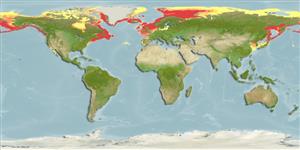Common names from other countries
Classification / Names / Names
Populärnamn | synonymer | Catalog of Fishes (gen., sp.) | ITIS | CoL | WoRMS
Environment: milieu / climate zone / depth range / distribution range
Ekologi
; djupintervall 0 - 1000 m (Ref. 116516), usually 10 - 100 m (Ref. 116516). Polar
Northern Atlantic, Pacific Ocean and the Arctic Ocean: Europe, USA, Scotland and Sea of Japan. Temperate to polar.
Length at first maturity / Size / Vikt / Age
Maturity: Lm ? range ? - ? cm Max length : 1.3 cm TL hane/ej könsbestämd; (Ref. 281)
Body: Oblong; moderately elevated. Valves: Dorsal surface, smoothish except for irregular concentric growth ridges and a very fine sandpaper effect; Color, whitish, cream, light-orange or rarely marked with brown. Girdle: Resembles sandpaper, with tiny, closely packed gravelly scales (Ref. 281).
Habitat: On or under stones; rocky shores (Ref. 293). Found from subtidal to 100 m (Ref. 75835).
Life cycle and mating behavior
Könsmognad | Reproduktion | Lek | Ägg | Fecundity | Larver
Members of the class Polyplacophora are mostly gonochoric. Life cycle: Eggs hatch into lecitotrophic planktonic trocophore larvae (no veliger stage) which later metamorphose and settle on the bottom as young adults.
Burghardt, G. and L. Burghardt. 2006. (Ref. 281)
IUCN Red List Status (Ref. 130435)
CITES status (Ref. 108899)
Not Evaluated
Not Evaluated
Human uses
| FishSource |
Verktyg
Ytterligare information
Age/SizeTillväxtLength-weightLength-lengthMorfologiLarverAbundans
Internet-källor
Estimates based on models
Preferred temperature
(Ref.
115969): 0.1 - 10.2, mean 2.8 (based on 2507 cells).
Vulnerability
Low vulnerability (10 of 100).
Price category
Unknown.
